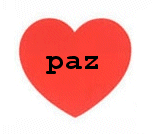John Bostrom

Any re-imaged peace symbol that hopes to gain popular acceptance must embrace the attitude expressed in Michael Jackson's deservedly popular "Man in the Mirror" - "if you want to make the world a better place, take a look at yourself and make that change." If peace doesn't come from within, it's simply not genuine and won't make it. This symbol simply and directly places the word for peace, in any language, on Glaser's famous heart (tribute!)
The original peace sign is inherently problematic. The designer, Gerald Holcomb, says that it's basically an abstraction of despair - "Goya's peasant before the firing squad." He regretted the negativity of this design, and the British organization for whom he made it apparently adopted the only slightly less negative explanation that the designs stands for the semaphore letters N and D (for Nuclear Disarmament) = a construct that deservedly remains in the archives of obscurity. Nevertheless the basic message conveyed by the symbol remains, if not despair, then "surrender" - laying down your arms. This is how it was widely understood in the sixties. Protesters would even extend their arms downward to become "human peace symbols." Which plays right into the image of peacemakers as cowardly, gutless, irresponsible if not drug-addled hippy-dippy flower children who really stand for nothing, at least nothing requiring any effort or discipline. Hardly the case, but that's the enduring legacy of the image.